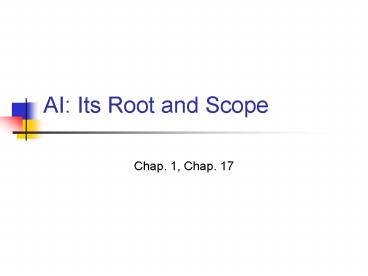AI: Its Root and Scope - PowerPoint PPT Presentation
1 / 28
Title:
AI: Its Root and Scope
Description:
Machine Translation Project (NRC) The History of AI. Knowledge-based systems ... Machine translation. Text understanding. Autonomous vehicles, robotics. Data ... – PowerPoint PPT presentation
Number of Views:85
Avg rating:3.0/5.0
Title: AI: Its Root and Scope
1
AI Its Root and Scope
- Chap. 1, Chap. 17
2
What is Intelligence?
- Understanding
- Perception (vision, speech), language
understanding - Reasoning
- Given facts ? new facts
- Learning
- Improving performance as it repeats
- Adaptiveness, Creativity, etc.
3
What is Intelligence?
- Turing Test
- Alan Turing (1950) - Can machine be intelligent?
- 2006 Turing test (Loebner contest)
- http//www.jabberwacky.com/george
4
What is Artificial Intelligence?
- Study of how to make computer do things that
people do better - To find how people think/act intelligently
- To develop systems that perform intelligent task
(perception, reasoning, learning, )
5
The History of AI
- Foundation
- What is mind and how it operates?
- How to automate the mental process?
- Gestation
- Artificial neuron (McCulloch Pitts, MIT)
- Perceptron a computational model of neuron
- Logic Theorist (Newell Simon, CMU)
- Non-numerical problem solving - theorem proving
- Dartmouth workshop ? Artificial Intelligence
- Early enthusiasm
- Checker program (Samuel, IBM), GPS (Newell
Simon, CMU), ELIZA (Weizenbaum, MIT), SHRDLU
(Winograd, MIT), - LISP (McCarthy, MIT)
- Machine Translation Project (NRC)
6
The History of AI
- Knowledge-based systems
- DENDRAL (Buchanan, Stanford)
- Identify molecule structure by using mass
spectrum data - MYCIN (Feigenbaum, Buchanan, Stanford)
- Medical diagnosis
- LUNAR (Woods)
- Successful NLP interface to geology DB
- Industry
- Commercial expert systems
- AI companies
- 5th generation computer project (Japan)
- MCC project (USA)
- Return of neural network
- PDP(Parallel and Distributed Processing)
7
The History of AI
- Current trends
- Toy examples ? Real world applications
- Ad hoc ? Statistical
- Various practical applications
- Real-time expert systems
- Speech / image recognition
- Machine translation
- Text understanding
- Autonomous vehicles, robotics
- Data mining
- Web agents
- Game
8
Areas/Applications of AI
- Reasoning
- VLSI verification, Fuzzy control
- Expert systems
- Medical, financial, design, scheduling, law
- Vision
- Face recognition, autonomous vehicle
- Speech recognition
- Voice recognition, speech translation
- Natural language understanding
- Information extraction, machine translation
9
Areas/Applications of AI
- Machine learning
- Neural networks, data mining, classification,
prediction - Robotics
- Motion planning, assembly planning
- Game playing
- Chess, NPC control
- Web agents
- Personal desktop agent, recommender systems,
e-commerce agent
10
Symbolic vs. Connectionist
- Symbolic AI
- Physical symbol system hypothesis
- Intelligence is achieved through
- Symbol patterns to represent problems
- Operations on the patterns to generate potential
solutions - Search to select a solution
- Logical inference
- Knowledge-based systems
11
Symbolic vs. Connectionist
- Connectionist AI
- Modeling human brain
- Intelligent behavior is achieved by
- Large number of connected processing element
- Learning of the network
- Neural Networks
12
Conversation with Robots
- KISMET
- A robot made in MIT AI lab
- Vision object recognition, movement detection
- Speech recognition
- Attention/Behavior control
- Speech generation
- Introducing emotions, belief, desire
- Expression examples
- Focusing
- Dialog with humans
13
The Chinese Room Experiment
- John Searl (1980)
- Experiment
- Searls argument
- The man in the room does not have any
understanding - No matter how intelligent-seeming a computer
behaves and no matter what programming makes it
behave that way, since the symbols it processes
are meaningless (lack semantics) to it, it's not
really intelligent. It's not actually thinking.
14
The Brain Prosthesis Experiment
- John Searl (1980),
- Hans Moravec (1988)
- Experiment
- Will you remain conscious?
- Hans Moravec(1988) Yes. It will show exactly
same behavior with real brain. The mechanism
involved in consciousness are still operating in
the electronic brain, which is therefore
conscious - John Searl(1980) No. You would end up loosing
your control over your behavior. (Problem The
consciousness cannot be removed instantaneously)
15
The Worlds First Brain Prosthesis Artificial
Hippocampus
16
Can Machines Think?
- Am I thinking or what?
- Intelligence? (weak AI)
- yes, in narrow sense.
- Consciousness? (strong AI)
- debate unsolved.
17
EasyDiagnosis Expert System
18
EasyDiagnosis Expert System
19
MAPGEN (Mixed Initiative Activity Planning
Generator)
20
SHYSTER
21
Autonomous Vehicles
- Mars Autonomy - Long-distance marsrover
navigation with minimal human intervention.
- UGV - unmanned ground vehicle for reconnaissance,
surveillance, and combat.
22
ECTACOs Voice Translator for Pocket PC
23
ezTrans by ChangShin Soft
24
Classification of Tumors
25
Brain MRI Classification
26
IBM Deep Blue
27
NPC Control
28
Recommender Systems































